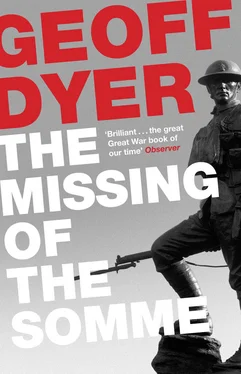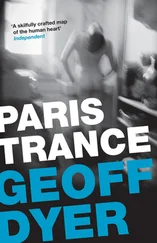With its shattered trees and ‘eerie’ calvaries this war-ravaged landscape felt, in Sassoon’s words, ‘like the edge of the world’. On wet days ‘the trees a mile away were like ash-grey smoke rising from the naked ridges, and it felt very much as if we were at the end of the world’.
Fussell uses passages like these to show how English writers viewed the war through a filter of ‘ritual and romance’ — specifically, in Sassoon’s case, William Morris’s The Well at the World’s End. Ironically, this world’s end landscape in which the English poets found themselves was the realization in hideous, distorted form of the great visions of German Romanticism.
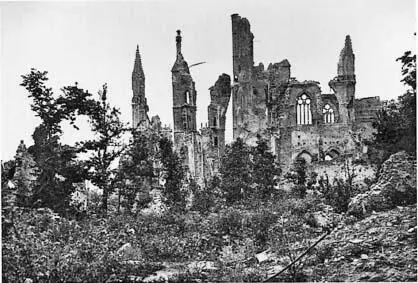
The ruins of Ypres Cathedral, summer 1916
Freed from their immediate context, passages like these add up to an evocation of landscape that had been set down on canvas over a century earlier by Caspar David Friedrich. His Abbey Under Oak Trees of 1810 shows ravaged trees and the remains of a church rising through the mist; a funerary procession of figures bears a coffin through graves scattered haphazardly across the foreground. The German poet Karl Theodor Korner referred to this picture in 1815 as a Totenlandschaft , ‘a landscape of the dead’. Exactly a century later Robert Musil, serving as an officer in the Austrian army, used precisely the same word to describe the scene he had witnessed on the Italian front.
As the war took its toll, even archetypal Romantic remnants like the ruined walls of abbeys were frequently blasted beyond recognition. At the edge of the allied world, near Ypres, all that could be seen was ‘a sea of mud. Literally a sea.’ In 1917 Blunden looked out across ‘a dead sea of mud’ and Stephen Graham, revisiting the area in 1920, was confronted by a ‘landocean’. When the film director D. W. Griffith travelled to the Western Front as part of his preparation for the film Hearts of the World , he was disappointed by the dramatic potential of the war:
As you look out over No Man’s Land there is literally nothing that meets the eye but an aching desolation of nothingness. . No one can describe it. You might as well try to describe the ocean.
The wife of an artist friend of Friedrich’s was similarly disappointed by the 1809 painting The Monk by the Sea : there was nothing to look at. ‘By any earlier standards,’ notes art historian Robert Rosenblum,
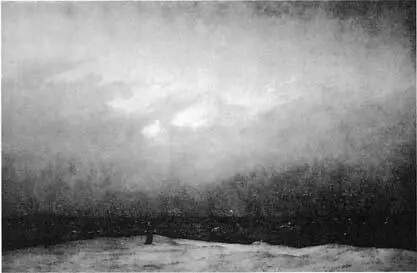
The Monk by the Sea , by Caspar David Friedrich
she was right: the picture is daringly empty, devoid of objects. . devoid of everything but the lonely confrontation of a single figure, a Capuchin monk, with the hypnotic simplicity of a completely unbroken horizon line, and above it a no less primal and potentially infinite extension of gloomy, hazy sky.
With only a minimum of changes, Rosenblum’s words can serve equally well as a description of a panoramic photograph by William Rider-Rider which reproduces Friedrich’s vision in the devastated battlefield of Passchendaele.
The scene is divided evenly between land and sky. A line of blasted trees separates the shattered foreground from the land-ocean, the sea of mud, which, as in The Monk by the Sea , reaches to the horizon. Instead of receding into the distance, these trees disappear beyond the edges of the frame. There is no perspective. The vanishing-point is no longer a more or less exact point, but all around. A new kind of infinity: more of the same in every direction, an infinity of waste. The sky lies in tatters in the mud. It is impossible to tell what time of day the photo was taken. There is no direct source of light — just the grey luminosity of the sky. In the middle of the picture, instead of Friedrich’s monk, there is an unknown soldier, smoking. Nothing is moving. Hence, despite the endless desolation, the strange serenity of the photograph.
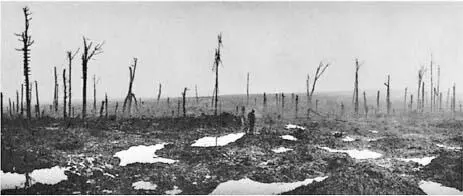
An infinity of waste
Ruins, for the Romantics, fulfilled the useful function of being enduring monuments to transience: what faded as grandeur survived as ruins. As testaments to their own survival, ruins, typically, had the story of their own ruination inscribed within them. Wordsworth established an imaginative template with the stories of silent suffering read in the ruins of ‘Michael’ or ‘The Ruined Cottage’. So pervasive was the cult of ruination that a ruin became a place where a certain set of responses lay perfectly intact.
The Great War ruined the idea of ruins. Instead of the slow patient work of ruination observed in Shelley’s ‘Ozymandias’, artillery brought about instant obliteration. Things survived only by accident or chance — like the calvary at Ypres — or mistake. Destruction was the standard and the norm. Cottages and villages did not crumble and decay — they were swept away.
In France, researching his book on the Battle of the Somme in March 1917, John Masefield described the area around Serre as
skinned, gouged, flayed and slaughtered, and the villages smashed to powder, so that no man could ever say there had been a village there within the memory of man.
In Barbusse’s Under Fire the squad are making their way to the village of Souchez when the narrator realizes they are already there:
In point of fact we have not left the plain, the vast plain, seared and barren — but we are in Souchez!
The village has disappeared. . There is not even an end of wall, fence, or porch that remains standing.
Revisiting the scenes of battle near Passchendaele in 1920, Stephen Graham finds himself — or loses himself, more accurately — in what Barbusse calls a ‘plain of lost landmarks’:
The old church of Zandwoorde cannot now be identified by any ruins — one has to ask where it was. Even the bricks and the stones seem to have been swept away.
Considering the same area of land half a century later, Leon Wolff puts the scale of destruction in its historical context: ‘In a later war, atomic bombs wrecked two Japanese cities; but Passchendaele was effaced from the earth.’
Shunning such emotive turns of phrase, Denis Winter emphasizes that the Somme presented a scene of devastation even more thorough than that observed in Belgium: ‘Aerial photos of Passchendaele in its final stages show grass and even trees. By autumn 1916, on the other hand, there was no vestige of grass on the Somme.’
Passchendaele, Albert and other villages in the Somme were rebuilt, but to some of the villages around Verdun the inhabitants never returned. Fleury, Douaumont and Cumières vanished from the map for ever.
Ruins rise from the ashes of the Great War with the Nazis and Albert Speer’s ‘Theory of Ruin Value’. Instead of being remnants of the past, Speer’s ruins are projected into a distant future — a future stretching even beyond the thousand-year Reich. With Hitler’s enthusiastic approval Speer set about designing structures and using materials to ensure that, even after generations of decay, the ivy-grown columns and crumbling walls of the Reich would have the ruined splendour of the great models of antiquity.
In the occupied countries the all-obliterating destruction of the Great War could be raised by the Nazis to the level of strategic principle. The fate of the Czech village of Lidice has been described by Albert Camus. The houses were burned to the ground, the men were shot, the women and children deported. After that
Читать дальше
